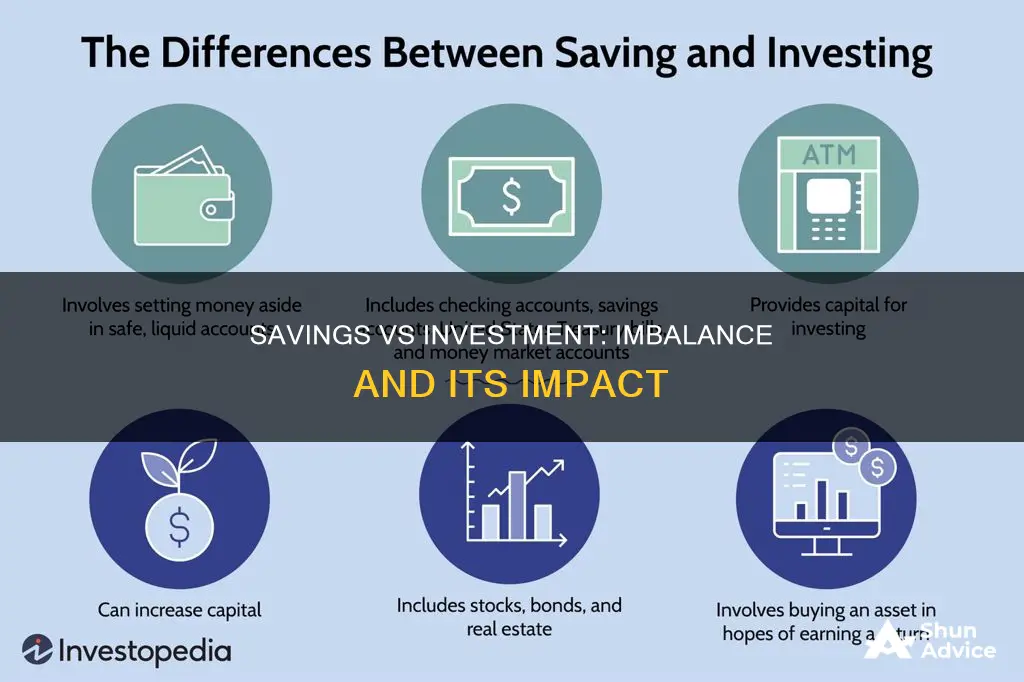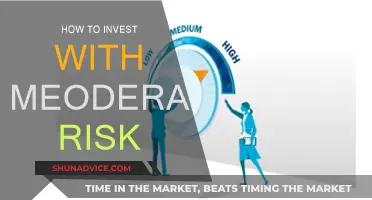
When aggregate savings exceed aggregate investment, the economy is producing more than it is spending. This results in an economic disequilibrium, where there is an excess of output that cannot be absorbed by the market. Consequently, businesses will adjust by reducing production, leading to a decrease in GDP and employment. This scenario is often associated with an economic contraction or recession, as companies cut back on operations to manage their inventories and resources.
| Characteristics | Values |
|---|---|
| Equilibrium | Not achieved |
| Inventories | Accumulate |
| Output | Falls |
What You'll Learn

Savings and investment equilibrium
The equilibrium output, or GDP, in an economy is determined by the Aggregate Expenditures Model. This model is based on the assumption that the production of final goods and services in an economy (the GDP) results in a flow of income that is exactly equal to the value of that output. In this model, spending is considered in terms of GDP instead of income.
The equilibrium point in the model is where GDP, or output, is equal to spending (consumption + investment). At this point, if you move away from it, natural market forces should automatically move you back toward the equilibrium.
For example, if the economy is producing at a higher level of GDP than the equilibrium, total spending will be less than output. In this case, there will be unwanted inventories building up, which will be a signal to reduce production. As production is reduced, output or GDP falls until it reaches the equilibrium point.
On the other hand, if the economy is producing at a lower level of GDP than the equilibrium, total spending will be greater than output. In this case, there will be a depletion of inventories, which will lead to an increase in production. As production increases, output or GDP rises until it reaches the equilibrium point.
Equilibrium output is also achieved when leakages (savings) are equal to injections (investment). If savings are greater than investment, then GDP is too high, and output will fall. Conversely, if savings are less than investment, then GDP is too low, and output will rise.
This "leakages-injections" approach states that equilibrium GDP is where savings (leakages) are equal to planned investment (injections). If the leakage is greater than the injection, then aggregate spending will be less than GDP, and this level of GDP is too high to be sustained. Conversely, if the injection of investment exceeds the leakage of savings, then aggregate expenditures will exceed planned GDP, and GDP will be driven up.
John Maynard Keynes, in his book "The General Theory of Employment, Interest, and Money", published in 1936, provided an alternative to classical economic theory, which helped explain periods of recession. He suggested that recessions were not self-correcting and recommended government spending to induce more production. According to Keynes, investment creates savings, and not the other way around. This proposition seems to violate the fundamental intuition of economists and the general public.
In conclusion, the equilibrium output or GDP in an economy is determined by the Aggregate Expenditures Model, which equates output to spending (consumption + investment). Equilibrium is also achieved when savings (leakages) are equal to investment (injections). Deviations from equilibrium will lead to adjustments in production to return to the equilibrium point.
Saving and Investing: Pros, Cons, and Your Money
You may want to see also

GDP and employment decrease
When savings are greater than investment, GDP is too high and output will fall. This is because savings represent a "leakage" from the income-expenditures stream, while investment adds spending to the flow of income. When the leakage is greater than the injection, aggregate spending will be less than GDP, and this level of GDP is too high to be sustained.
In this scenario, inventories will increase, and companies will slow down production to compensate for the reduction in expenditures. This will lead to a decrease in both real GDP and employment.
For example, if a company produces 125,000 trucks but only sells 100,000, the remaining 25,000 trucks are added to inventory, resulting in an unexpected increase in investment. The company will then slow down production, leading to a reduction in employment.
If this occurs throughout an entire economy, we will see a decrease in GDP as companies work to slow their production. Inventories will increase, forcing companies to reduce output to match the lower level of expenditures. This will result in decreased GDP and employment.
Additionally, a decrease in investment spending can also lead to decreased GDP and employment. Investment is a volatile component of aggregate expenditure, and it is influenced by expectations of future profitability and the real interest rate. When expected future profitability decreases, a company's appetite for investment risk will decrease, leading to reduced investment. Similarly, when the real interest rate increases, the cost of borrowing goes up, reducing investment spending.
In summary, when aggregate savings exceed aggregate investment, there is a decrease in GDP and employment due to companies slowing down production to match reduced expenditures. This is further exacerbated by a decrease in investment spending, which is influenced by expectations of future profitability and the real interest rate.
A Safe Investment: Post Office Savings Schemes
You may want to see also

Macroeconomic equilibrium
The relationship between savings and investment is a fundamental concept in economics, and different theories, such as Keynesian and orthodox theories, offer varying perspectives. According to Keynesian economics, investment creates savings, while orthodox theories suggest the opposite—that savings facilitate investment.
When aggregate savings exceed aggregate investment, it indicates an imbalance in the economy. This situation can lead to a decrease in output and employment. Businesses will have excess inventory, signalling a need to reduce production. As a result, the gross domestic product (GDP) will decline.
To restore equilibrium, economic forces will drive savings towards investment. This can occur through various channels, such as reduced interest rates, which encourage more borrowing for investment, or increased consumption, which stimulates economic growth and creates a demand for investment.
On the other hand, when aggregate savings are less than aggregate investment, it signifies a different type of imbalance. In this scenario, businesses experience higher demand than their current production levels, leading to a depletion of inventories. This, in turn, incentivises businesses to increase production, resulting in an increase in GDP and employment.
The equilibrium level of output, income, and employment in an economy can be explained through the consumption-income and saving-income relationships. These relationships are captured in models like the Aggregate Expenditures Model, which helps determine equilibrium output or GDP.
In summary, macroeconomic equilibrium is a dynamic state where economic forces work to balance savings and investment. When aggregate savings deviate from aggregate investment, corrective mechanisms come into play to restore equilibrium. This process is essential for maintaining a stable and functional economy.
Monthly Savings: Invest Wisely, Grow Your Wealth
You may want to see also

Aggregate demand and supply
Aggregate Demand
When savings are greater than investment, it can indicate that consumers are choosing to save more of their disposable income rather than spending it. This can lead to a decrease in aggregate demand as consumers are spending less on goods and services.
However, it's important to note that aggregate demand is also influenced by other factors such as disposable income levels, wealth, interest rates, and expectations of future income. For example, if consumers expect their income to increase in the future, they may increase their spending in the present, even if their current savings are high.
Additionally, changes in the price level can impact aggregate demand. If the national price level increases, goods and services become more expensive, and consumers may not be able to afford to purchase as much. On the other hand, if prices fall, consumers may be able to purchase more, leading to an increase in aggregate demand.
Aggregate Supply
While savings and investment can impact aggregate demand, their direct effect on aggregate supply is less clear. Aggregate supply refers to the total supply of goods and services produced by an economy, and it is primarily influenced by factors such as the level of technology, physical capital, human capital, and productivity.
However, investment in physical capital, such as machinery and equipment, can contribute to increasing aggregate supply over time by improving productivity and production capacity. Therefore, while high savings may not have a direct impact on aggregate supply, they can indirectly influence it by providing funds for investment in capital goods.
Equilibrium
The equilibrium level of output, or gross domestic product (GDP), in an economy is achieved when aggregate demand equals aggregate supply. Changes in savings and investment can disrupt this equilibrium.
For example, if savings exceed investment, it could lead to a decrease in aggregate demand, causing a situation where supply exceeds demand. This may result in an excess of inventory for businesses, leading them to reduce production. Consequently, output or GDP would fall until a new equilibrium is reached.
On the other hand, if investment exceeds savings, it could stimulate aggregate demand and cause a situation where demand exceeds supply. Businesses would need to increase production to meet the higher demand, leading to an increase in output or GDP until a new equilibrium is established.
The Multiplier Effect
It is also important to consider the multiplier effect, which states that a change in investment or government spending can have a disproportionate impact on aggregate demand and, consequently, on output or GDP.
For example, an increase in investment can lead to higher incomes for firms, which then get distributed to workers, landlords, suppliers, and shareholders. These economic agents will then spend a portion of their increased income, creating new income for other sellers. This process continues, and the initial increase in investment gets multiplied throughout the economy, leading to a more significant impact on aggregate demand and output.
In summary, while the relationship between aggregate savings, investment, and their impact on aggregate demand and supply is complex, it is clear that they play a crucial role in determining the equilibrium level of output in an economy.
Transferring Funds: Ally Invest to Ally Savings
You may want to see also

Leakages and injections
The three injections included in the model are investment expenditures, government purchases, and exports. These are termed injections because they are "injected" into the core circular flow of consumption, production, and income. Investment expenditures, for example, can cause a knock-on effect throughout the economy, as the initial increase in investment causes a rise in output, which leads to higher incomes, which is then spent, causing a further rise in aggregate demand.
The three leakages included in the model are saving, taxes, and imports. These are termed leakages because they are "leaked" out of the core circular flow of consumption, production, and income. Leakages reduce the money available throughout the rest of the economy. For example, imported goods can transfer income earned in one country to another, causing an outflow of funds from the domestic economy.
Equilibrium in the injections-leakages model is achieved when there is a balance between injections and leakages, meaning the volume of the core circular flow remains constant. However, if injections exceed leakages, the volume of the basic flow expands, and aggregate production increases. Conversely, if leakages exceed injections, the volume of the basic flow contracts, and aggregate production decreases.
Investing While Saving for a Home: Wise or Risky?
You may want to see also
Frequently asked questions
When aggregate savings exceed aggregate investment, it indicates an imbalance in an economy where savings are not being channelled effectively into productive investments. This situation can lead to reduced economic growth and other economic implications.
When savings are greater than investment, it implies that GDP is too high relative to the equilibrium level, and this excess output will lead to a fall in GDP as businesses adjust their production to match actual spending.
Businesses will experience an accumulation of inventories as their products are not being purchased at the same rate they are being produced. This will prompt businesses to reduce their production to prevent further inventory buildup, leading to a decrease in overall output.
As businesses scale down their production, they may also reduce their workforce, resulting in lower employment levels. This decrease in employment further contributes to a decline in consumption and investment demand, creating a downward spiral.
Yes, during economic downturns or periods of uncertainty, individuals and businesses tend to save more and invest less. This behaviour can prolong or exacerbate the economic slowdown.







